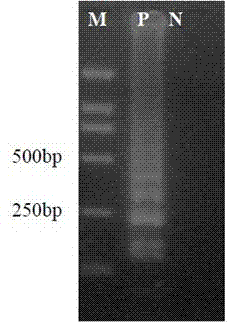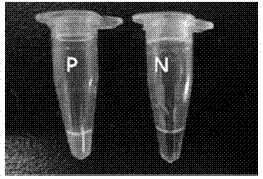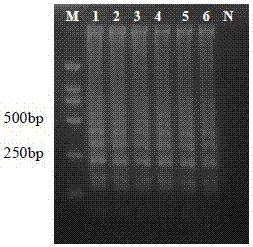Primer group for detecting clonorchis sinensis and detection method thereof
A clonorchis sinensis and detection method technology, applied in the field of parasite molecular detection, can solve the problems of low sensitivity, cumbersome detection method of clonorchis sinensis, long detection time, etc., and achieve low interference, high detection rate, and accuracy sex high effect
- Summary
- Abstract
- Description
- Claims
- Application Information
AI Technical Summary
Problems solved by technology
Method used
Image
Examples
Embodiment 1
[0040] Example 1 Detection of intermediate host C. sinensis
[0041] 1. Processing of intermediate host samples of Clonorchis sinensis to be tested:
[0042] 31 fish samples, 42 shrimp samples and 91 snail samples were collected in Yangshan County, Qingyuan City, and Sanshui District, Foshan City, Guangdong Province. Soak the collected snail samples in clear water for 24 hours and remove the shells, and remove the shells directly from the shrimp samples.
[0043] 2. Extraction of DNA from the intermediate host sample of Clonorchis sinensis to be tested:
[0044] (1) Add 200 μl proteinase K lysate to the treated sample to be tested, and digest it in a water bath at 55°C for 4-8 h;
[0045] (2) Take out the sample in step (1), add a mixture of phenol: chloroform: isoamyl alcohol with a volume ratio of 25:24:1, shake and mix at room temperature to form an emulsion, and then let it stand for 2-5 minutes;
[0046] (3) Centrifuge the mixture in step (2), and transfer the upper ...
Embodiment 2
[0059] Example 2 Determination of the temperature of the Clonorchis sinensis LAMP detection system
[0060] Use the total DNA of samples positive for Clonorchis sinensis as a template to determine the temperature of the LAMP detection system for the intermediate host of Clonorchis sinensis, the method is as follows:
[0061] 1. According to the method of Example 1, the total DNA of the intermediate host of Clonorchis sinensis was extracted.
[0062] 2. Carry out LAMP detection according to the method of Example 1, retain the total DNA of the intermediate host sample positive for Clonorchis sinensis, and use it as a template for determining the temperature of the LAMP detection system for the intermediate host of Clonorchis sinensis.
[0063] 3. Determination of the temperature of the LAMP detection system:
[0064] (1) Establish a loop-mediated isothermal amplification reaction system
[0065] LAMP reaction buffer (Reaction Buffer): Each 90ml LAMP reaction buffer contains ...
Embodiment 3
[0068] Example 3: Determination of the time of the LAMP detection system for the intermediate host of Clonorchis sinensis
[0069] Use the total DNA of samples positive for Clonorchis sinensis as a template to determine the time of the LAMP detection system for the intermediate host of Clonorchis sinensis, the method is as follows:
[0070] 1. According to the method of Example 1, the total DNA of the intermediate host of Clonorchis sinensis was extracted.
[0071]2. Carry out LAMP detection according to the method of Example 1, retain the total DNA of the intermediate host sample positive for Clonorchis sinensis, and use it as a template for determining the time of the Clonorchis sinensis intermediate host LAMP detection system.
[0072] 3. Determination of the time of the LAMP detection system:
[0073] 1) Establish a loop-mediated isothermal amplification reaction system
[0074] LAMP reaction buffer (Reaction Buffer): Each 90ml LAMP reaction buffer contains the followi...
PUM
 Login to View More
Login to View More Abstract
Description
Claims
Application Information
 Login to View More
Login to View More - R&D
- Intellectual Property
- Life Sciences
- Materials
- Tech Scout
- Unparalleled Data Quality
- Higher Quality Content
- 60% Fewer Hallucinations
Browse by: Latest US Patents, China's latest patents, Technical Efficacy Thesaurus, Application Domain, Technology Topic, Popular Technical Reports.
© 2025 PatSnap. All rights reserved.Legal|Privacy policy|Modern Slavery Act Transparency Statement|Sitemap|About US| Contact US: help@patsnap.com



